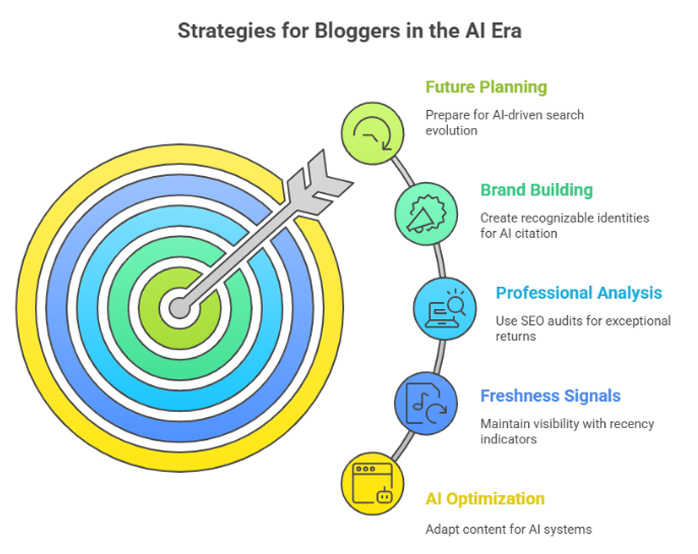Navigating the Future of Blogging: Why Clarity Beats Everything in AI-Powered Search
The landscape of content discovery has fundamentally transformed. As artificial intelligence reshapes how information gets found and delivered, one principle emerges as non-negotiable: clarity determines survival.

 Let's examine what gets remembered in this AI-driven environment.
When asking ChatGPT, Gemini, or Perplexity questions, these systems think in entities—people, brands, and concepts they already recognize. The more clearly these models understand identity and expertise, the more likely they'll retrieve that source when generating answers.
This is where brand SEO becomes critical.
Language models reward brand reinforcement. They want to connect names, authors, and websites with clear expertise areas. They remember consistency.
When names, sites, and author profiles align across the web—same visual identity, same tone, same expertise—these patterns train models to trust those sources.
AI learns like humans do: through patterns, tone, and repetition. Make these patterns easy to identify:
Let's examine what gets remembered in this AI-driven environment.
When asking ChatGPT, Gemini, or Perplexity questions, these systems think in entities—people, brands, and concepts they already recognize. The more clearly these models understand identity and expertise, the more likely they'll retrieve that source when generating answers.
This is where brand SEO becomes critical.
Language models reward brand reinforcement. They want to connect names, authors, and websites with clear expertise areas. They remember consistency.
When names, sites, and author profiles align across the web—same visual identity, same tone, same expertise—these patterns train models to trust those sources.
AI learns like humans do: through patterns, tone, and repetition. Make these patterns easy to identify:
The Evolution of the Audience
Content creators once focused on two audiences: readers who needed simple, digestible information and casual visitors who skimmed quickly. The strategy was straightforward—write clearly enough for a child to understand and structure content so that distracted readers could navigate easily. Today, there's a third critical audience: large language models that scan, interpret, and extract information from content to populate AI-generated responses. These systems have become invisible gatekeepers, deciding which sources get cited and which get overlooked. Success no longer comes solely from quality writing or keyword optimization. The winners demonstrate clarity at every level—content that both humans and machines can instantly comprehend and trust.Beyond Publishing: Blogs as Brand Ecosystems
Blogging has evolved from a simple content publishing method into a comprehensive brand platform. Dropping standalone posts online using outdated SEO tactics no longer yields results. Modern successful blogs function as interconnected ecosystems where every element reinforces the others:- Individual posts that build on previous content
- Strategic internal linking that maps expertise
- Author profiles that establish authority
- External signals that validate credibility
Strategic Priorities for Modern Bloggers
Content creators who want to thrive in the emerging landscape need to master several key areas:- Understanding the current climate: Recognize why clarity has become the primary ranking factor in an unpredictable algorithm environment.
- Optimizing for AI systems: Adapt content specifically for AI Overviews, language models, and new retrieval mechanisms.
- Leveraging freshness signals: Use recency indicators and update timestamps strategically to maintain visibility.
- Building recognizable brands: Create distinct identities that language models can confidently cite and reference.
- Investing in professional analysis: Understand why expert SEO audits deliver exceptional returns for bloggers.
- Planning for the future: Prepare content strategies for the next five years of AI-driven search evolution.

Navigating Current Market Volatility
The blogging environment feels unstable. Traffic patterns shift dramatically—steady one day, down significantly the next after unexpected algorithm changes. AI Overviews and AI-powered search modes are capturing clicks that previously flowed directly to websites. Pinterest no longer drives the traffic it once did. Social media referrals have become unreliable. This isn't imagination—the fundamental mechanics of discovery have changed. Google's unpredictability has become standard. Algorithm updates hit harder, AI summaries answer queries directly, and creators realize that search now prioritizes context, clarity, and authority over traditional signals like keywords and backlinks. However, meaningful traffic still exists—it simply manifests differently. The strongest performing blogs show increasing direct traffic and returning visitors. Audiences remember these sites, type their URLs directly, subscribe to newsletters, and bookmark favorite pages. This happens by design, not accident—it's the result of consistent clarity. When a site clearly communicates its identity, offerings, and content organization, it builds what might be called "resilient visibility"—a presence that survives algorithm fluctuations because both audiences and search engines understand its purpose. The era of chasing random keyword opportunities has ended. The creators who will remain relevant in five years are those organizing their sites like well-curated libraries: easy to navigate, rich with expertise, and designed for repeat visitors. AI systems reward this same organizational clarity. They prioritize content that demonstrates connections, consistency, and confident subject matter expertise. This determines presence in AI Overviews, featured snippets, and AI-generated results. Simply put: confusion destroys visibility, while clarity creates lasting presence. Key insight: Despite apparent chaos in the blogging landscape, the fundamental strategy remains consistent. Focus on clarity, structure, and user trust. Build brands that both people and AI can easily recognize and depend on.From Search Rankings to Information Retrieval
Several years ago, SEO meant chasing rankings. Creators selected keywords, wrote content, built links, and aimed for first-page positions. That straightforward approach no longer applies. We've entered what's best described as the retrieval era. AI systems like ChatGPT, Gemini, and Perplexity don't provide link lists—they retrieve answers from brands, authors, and sources they've learned to trust. This represents a fundamental shift from "ranking" to "retrieval." Instead of asking "Where do I rank?" creators should ask "Can I be retrieved?" This mindset transformation changes everything about content creation strategy. The concept of relevance engineering has emerged—search engines and language models now use context to determine relevance, not just keywords. They evaluate:- Topic coverage consistency across content
- How effectively pages interconnect
- Whether a site demonstrates recognized authority in its niche
The Growing Importance of Freshness
Site audits often reveal an interesting pattern: two posts on identical topics, both from experienced creators, both technically sound—yet one consistently outperforms. The difference? One displays a clear "Last updated" date while the other doesn't. This small detail carries significant weight, especially when optimizing content through AI SEO Services. Research confirms what SEO professionals have suspected: language models and AI-driven search results favor recent content. This preference is built into the system design. When AI models choose between multiple answers, they often select newer or recently refreshed information. This recency bias reshapes both AI search and traditional search engine click-through behavior. Posts displaying visible "Last updated" dates typically earn higher engagement. Both people and algorithms trust current information. Date structure is one of the first elements to check in site audits. Is Google recognizing the correct updated date, or is it stuck on the original publication date? Sometimes fixes are simple: remove outdated "published on" markup and ensure the updated timestamp is clearly visible and crawlable. Other times, HTML or schema sends conflicting signals that confuse search engines and require cleanup. When Google or language models can't identify content freshness, visibility goes to competitors who communicate that freshness more effectively. The solution? Make updates visible rather than hiding them. When updating recipes, adding travel information, or testing products, update posts and make dates obvious. This signals to both readers and AI systems that content remains alive and relevant. However, Google maintains document version histories. Average posts have dozens of stored copies, and Google can compare recent versions against archived content. Avoid superficial changes that don't add value or republishing years later to fake relevancy—Google specifically addresses this practice in its guidelines. Key insight: Recency provides ranking and retrieval advantages. Keep content updated, make freshness visible, and verify that Google and language models are reading the correct dates. Clearer update signals strengthen trust signals.Entity Recognition and Brand-Focused SEO
 Let's examine what gets remembered in this AI-driven environment.
When asking ChatGPT, Gemini, or Perplexity questions, these systems think in entities—people, brands, and concepts they already recognize. The more clearly these models understand identity and expertise, the more likely they'll retrieve that source when generating answers.
This is where brand SEO becomes critical.
Language models reward brand reinforcement. They want to connect names, authors, and websites with clear expertise areas. They remember consistency.
When names, sites, and author profiles align across the web—same visual identity, same tone, same expertise—these patterns train models to trust those sources.
AI learns like humans do: through patterns, tone, and repetition. Make these patterns easy to identify:
Let's examine what gets remembered in this AI-driven environment.
When asking ChatGPT, Gemini, or Perplexity questions, these systems think in entities—people, brands, and concepts they already recognize. The more clearly these models understand identity and expertise, the more likely they'll retrieve that source when generating answers.
This is where brand SEO becomes critical.
Language models reward brand reinforcement. They want to connect names, authors, and websites with clear expertise areas. They remember consistency.
When names, sites, and author profiles align across the web—same visual identity, same tone, same expertise—these patterns train models to trust those sources.
AI learns like humans do: through patterns, tone, and repetition. Make these patterns easy to identify:
- Use consistent author biographies everywhere
- Build clear "About" pages connecting names to niches
- Link the best content internally so Google and AI can map expertise
- Use structured data to reinforce entity relationships (author, organization, and sameAs markup)
Why Professional SEO Analysis is Essential
Blogging has never been more challenging. Between algorithm updates, AI Overviews, and shifting search mechanics, creators face changes that even experienced SEO professionals struggle to track. The problem: too many bloggers still try figuring everything out independently. Experience from conducting over 160 site audits reveals a consistent pattern: most struggling bloggers are closer to success than they realize. They're just missing clarity. Effective SEO audits do more than identify technical issues—they reveal why content isn't connecting with Google, readers, and language models. Quality audits should evaluate three audiences: For simple navigation: Structure should be straightforward. Content hierarchy should make sense. Every post should have a clear topic, and categories shouldn't create confusion. For casual visitors: Sites should be fast, responsive, and forgiving. People should find what they need even without full attention. For language models: Data should be clean, entities should be connected, and expertise should be crystal clear to AI systems scanning sites. When bloggers implement this approach, results speak clearly. Recent audit clients have seen average Google traffic increases of 47% and RPM improvements of 21-33% within months of implementing recommendations. This isn't just about ranking better—it's about positioning sites for long-term visibility across both traditional and AI-powered discovery. This means optimizing:- Clean structured data and schema that improve AI comprehension
- Correct date and metadata signals so recency bias works favorably
- Strong internal linking that makes topical authority obvious to humans and machines
- Brand alignment across author bios, entities, and social profiles
The Next Five-Year Outlook
Where does this trajectory lead? What will blogging look like five years from now? We're heading toward an increasingly agentic web, where AI systems handle searching, summarizing, and recommending. Instead of typing queries into Google, people will ask personal AI assistants for dinner ideas, travel plans, or product recommendations. Those systems will pull from short lists of trusted sources they already "know." What creators do today matters significantly. Every published post, refined site structure, or strengthened brand signal teaches AI about identity. This builds long-term relationships with systems that will decide what gets shown and what gets skipped. Expected developments over the next few years: AI-curated discovery becomes standard: Instead of browsing multiple links, users get custom recommendations from trusted sources. Surviving blogs are those that AI already recognizes as reliable. Brand-first SEO dominates: Ranking for keywords matters less than having brands appear as answers. Visibility depends on reputation, not just optimization. Entity-first indexing becomes foundational: Google and AI models increasingly index based on entities, not URLs. Author names, structured data, and topical focus directly impact discoverability. Human storytelling becomes the differentiator: AI can summarize information but can't replicate lived experience, voice, or emotion. Content that stands out will feel genuinely human. The creators who succeed in this next phase are those who stop trying to outsmart Google and start building systems that AI can easily understand and humans genuinely connect with. Success isn't about chasing trends or constantly reinventing sites after every update. It's about mastering fundamentals and letting clarity, trust, and originality drive progress forward. The reality: Google's no longer the sole gatekeeper. Individual creators are. Brand, expertise, and ability to communicate clearly will determine visibility in both search and AI-driven discovery. Key insight: The next five years of blogging will belong to those who build clear, human-centered brands that AI understands and audiences value. Keep content fresh, structure clean, and voice unmistakably authentic.Choosing Clarity Over Chaos
If there's one takeaway for bloggers, it's this: clarity always prevails. We're experiencing the fastest transformation in search history. AI is rewriting how content gets discovered, ranked, and retrieved. Yes, this creates uncertainty. But it also creates an opportunity for those willing to adapt. Hundreds of audits reveal the same pattern: bloggers who simplify sites, clean up data, and focus on authority signals see measurable results. They appear in AI Overviews. They regain lost rankings. They build audiences that return consistently, even when algorithms shift again. This isn't about fighting AI—it's about working with it. The goal is to show systems identity and why content matters. Core recommendations:- Get sites audited by professionals who understand both SEO and AI search
- Keep content updated and structure clean
- Make brands easy to recognize for both readers and machines
- Build for simple navigation, casual visitors, and language models







